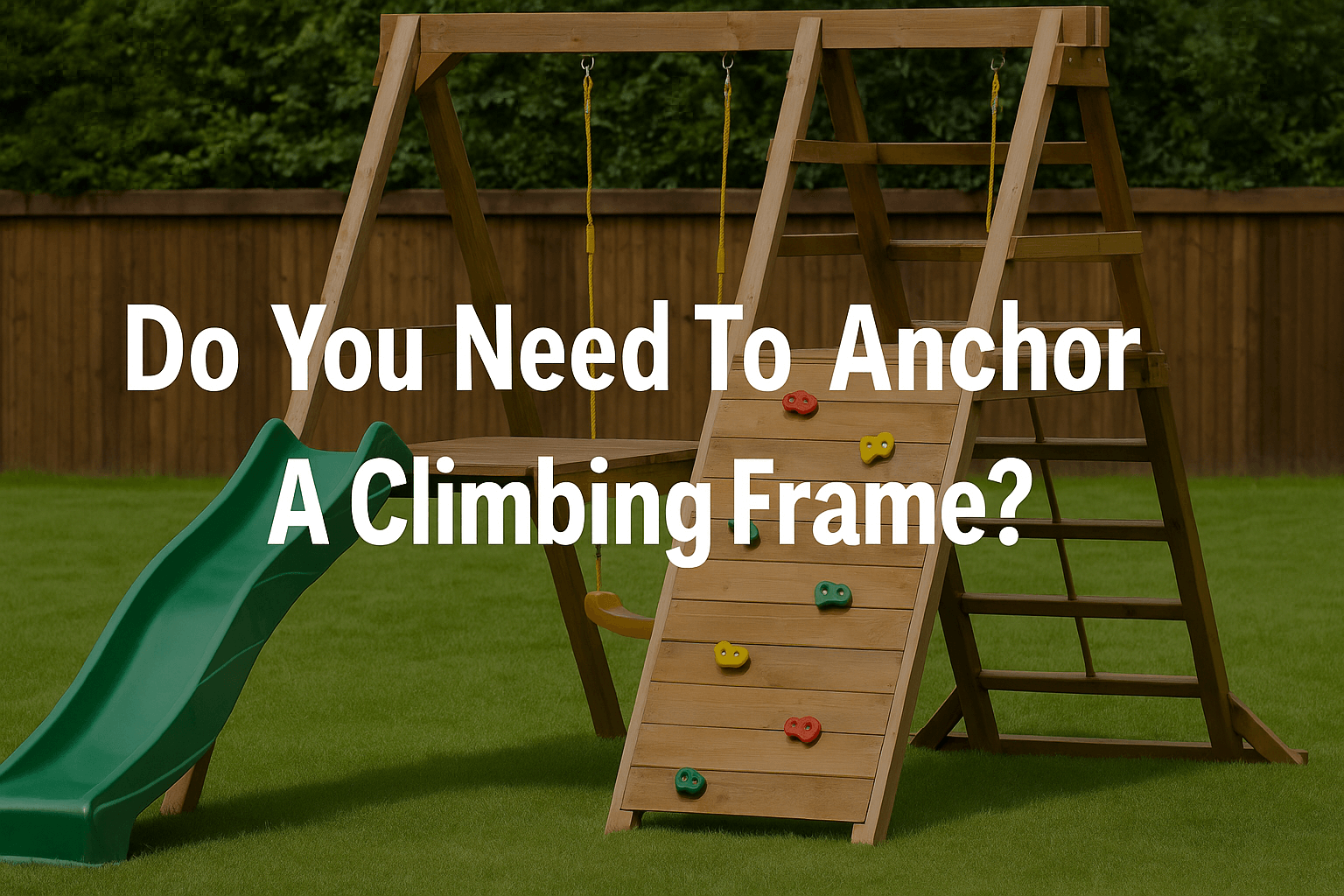
Do You Need To Anchor A Climbing Frame?
Do you need to anchor a climbing frame or play frame? Yes—absolutely. Unless you fancy it tipping mid-play or flying across the garden during a windy school run.
Anchoring keeps things safe, stable, and stress-free. Stick around to find out when it’s essential, how to do it, and why your future self will thank you.
The Importance of Anchoring Climbing Frames
Why Anchoring is Crucial for Safety
Picture this: it’s a breezy Saturday, the kids are climbing, and suddenly the whole play frame shifts. Heart-in-your-mouth moment, right?
That’s exactly why anchoring matters. It’s not just about keeping the frame in one place—it’s about keeping your children safe while they run, swing and hang upside-down like tiny gymnasts.
Preventing Tipping and Instability (wind, active play, weight distribution)
Even the sturdiest playsets can wobble if they’re not anchored down. Active kids don’t hold back, especially when there’s a slide involved or a game of “pirates on deck” happening up top.
Add in a gusty afternoon or uneven weight from a group of kids on one side, and you’ve got a recipe for tipping.
A well-anchored frame stands firm—no drama, no danger.
Meeting Safety Standards (ASTM, EN71, critical fall height)
When it comes to safety, it’s not just about what feels secure.
Standards like ASTM and EN71 set out the dos and don’ts for safe outdoor play. These take things like critical fall height into account—and guess what? That calculation assumes the frame won’t budge.
If your playset isn’t anchored, you’re not just risking bumps and bruises—you might also be falling short of essential safety requirements.

Factors Influencing the Need for Anchoring
Type and Size of Climbing Frame (large playsets vs. smaller structures)
A small toddler frame might look harmless, but once it starts rocking, it becomes a hazard. Bigger frames? Even more so.
Tall towers, multiple swings, and raised platforms all increase the need for anchoring. The higher the centre of gravity, the more likely it is to tip.
So whether it’s a compact garden frame or a full-blown wooden fortress, anchoring is your safety net.
Ground Surface (grass, concrete, uneven ground)
Got a soft grassy lawn? Great for bare feet, not so great for stability.
Play frames need a solid, level base—or the right anchors for the job. If your garden is on a slope, or if it’s been raining for days (hello, British weather), the ground might shift under pressure.
Concrete patios need specialised fixings. Uneven or loose soil? You’ll need longer anchors or a bit of clever reinforcement.
Usage and Activity Level
Think about how your kids play. Are they calm climbers or wild adventurers?
The more action a frame sees, the more wear it takes. Frequent use means more movement, more stress on the frame—and more need for solid anchoring.
Even a gentle nudge can make a loose frame dangerous over time.

Methods for Anchoring Your Climbing Frame
Common Anchoring Solutions
Let’s talk options. Anchoring doesn’t have to be complicated—but it does have to be done right.
Ground Anchors/Spikes (auger anchors, screw-in anchors)
Screw-in ground anchors are a go-to for many parents. They twist deep into soft soil and hold firm, even during wild play sessions.
Auger-style anchors are like giant corkscrews for your garden. Easy to install, and they don’t budge once they’re in.
Perfect for most wooden or metal playsets on grass or soil.
Concrete Foundations (sinking legs into concrete)
If you’ve got a patio or paved area, you’ll need something more heavy-duty. This is where concrete anchors come in.
Sometimes, installers will sink the play frame’s legs into concrete itself. It’s a bit more work up front—but the result is rock-solid, even on the windiest days.
Wooden Bracing and Cross Beams
This is the unsung hero of frame stability. Adding bracing or cross beams at the base spreads the load and stops sideways wobble.
It’s especially useful if your garden slopes or has uneven ground.
Anchors do the holding—beams do the balancing.
Step-by-Step Anchoring Process
Preparing the Ground for Anchors
First things first: prep the space.
Clear any debris, stones, or turf that could get in the way. Make sure you’re working on level-ish ground (as level as a British garden allows, anyway).
If the soil’s too soft, dig down until you find firmer earth—or think about reinforcing with slabs or hardcore.
Installing Various Anchor Types
Once the ground is ready, get your anchors in.
Screw-in models twist into place—no tools needed beyond a bit of muscle. For concrete fixings, you’ll need a drill, plugs, and bolts.
No matter the type, always follow the manufacturer’s instructions. And double-check each anchor before letting the kids loose on the frame.

Ensuring Secure and Lasting Stability
Best Practices for Anchoring
Checking for Stability After Installation
Once it’s all in place, give the frame a good shake. Seriously—better you test it than your five-year-old!
Look for movement at the base, swaying at the top, or any loose connections.
A properly anchored frame should feel like part of the ground, not a teetering sculpture.
Regular Inspection and Maintenance of Anchors
Over time, even great anchors can work loose. Check them every few months—or after heavy weather.
Keep an eye out for rust, wobbles, or signs that the ground around them is shifting. A quick tighten now can prevent a big problem later.
Think of it as MOT for your play frame.
When Professional Installation Might Be Needed
Complex Frame Designs
Got a climbing frame that looks like a mini adventure park? You might want a hand from the pros.
Multi-level designs, bridges, towers, or add-ons like monkey bars can be trickier to secure. It’s better to get it right first time than risk DIY regrets.
Challenging Ground Conditions
If your garden’s sloped, full of tree roots, or boggy after a downpour, anchoring becomes a whole different ball game.
A professional installer can assess the site and use the right techniques to ensure everything stays put.
It’s peace of mind—especially when you’re dealing with precious cargo.
Have you checked out our other posts?
How Long Do Wooden Climbing Frames Last?
How To Build A Climbing Frame?
How Do You Prepare The Ground For A Climbing Frame?
How To Secure A Swing On Grass?
How To Level A Climbing Frame?



Leave a comment